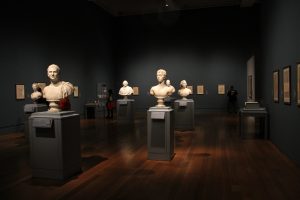
Blog Post 2
Technology and Public History
Overview:
This will be my second blog post for the course. The discussion point is regarding how methods and technologies of public history influences the types of digital public history being created today.
Therefore, the best way to breakdown this discussion topic is to talk about methods and then technologies of public history. While this beginning section will be brief, it will lay a foundation of terminology and method that will be employed in the second section of this blog.
The second section of the blog will discuss how these methods and technologies are being employed to help curate online exhibits for digital public history.
Part I: Methods and Technology
The first sub-discussion relates to methods. One of the primary methodologies relating to public history is that, according to Tammy Gordon’s article “Community Exhibition: History, Identity, and Dialogue”, a community exhibit is not a monograph or large narration from a singular, authoritative voice. Public history ought to be thought of as a memoir made “tactile and visible.” (35) Moreover, these public history sites are filled with first-hand accounts and oral histories. The evidence, therefore, is varied and not often used in academic historical works. (Gordon, pg. 36) Regarding the nature of public history sites, and the method of including oral histories was also talked about in Timothy Hart’s article “Storyteller – World War I”. In this work, Hart discusses how public history exhibits ought to be designed as a story, because stories are the easiest way to link the present to the past.
Overall, what both Gordon and Hart are discussing is the method of crafting a public history site. This site, therefore, is to be a story told to the visitor in order for the visitor to travel back in time to experience the past. Methodologically speaking, public history sites are similar to micro-historical monographs. Both offer a glimpse into the past via told and remembered stories.
The second sub-discussion relates to technology, and its usage within the public history domain. Hart also discusses that technology is to aid in directing the visitor to the main content of the public history site. Meaning, interactive message boards or touchscreen displays are not to distract the visitor from the main, historical content being curated. Simply, any and all technology ought to support the main, in-person exhibitions.
Scott Bomboy and Rebecca Sherman (“Museums and the Web, 2014) discuss how technology of public history sites are to also show engagement with the visitor. Simply, online blogs or social media posts are to create content that attracts readership via the opportunity for discussion. Blogs, according to Bomboy and Sherman, offer a great opportunity for museums to both offer content to the satellite visitor and offer the visitor to comment on the objects and be in dialogue with the curators.
Part II: Influence of Digital Public History
The question is: how does the methodology and technology of public history sites influence the formation of digital public history?
First and foremost, digital public history is to adhere to the same non-monograph nature as a in-person public history site. What Anne Lindsay notes in her article “Virtual Tourist” is that digital public history sites are to “court the virtual visitor” but creating a mirroring or continuation of historical discussion online just as one would be in-person. Most importantly, online public history sites are to present the same information in the same manner online just as it would be done for some one visiting in-person. Lindsay calls these visitors “virtual tourists”, and these are people “who seek the experience of tourism through a virtual interface.” (68) In the end, Lindsay notes that the method for online public history is shaped by physical history sites, the linear, argumentative fashion of in-person public history sites also applies to online, digital public history sites: to paraphrase Lindsay, online content that does not have physical or in-person counterpart creates a “segregated narrative.” (77)
Secondly, Natalia Dudareva in her article “Museums and the Web, Florence” denotes different types of engaged users. Her point here is that all online curate work is to have a purpose. Meaning, just as crafting an in-person exhibit the curator has a target audience in mind, the online exhibit too has a target audience in mind. Dudareva also notes that communication between the visitor and the curator (as it would in-person) is still an essential element to online work. She writes that digital work maintains museum communication to its visitors outside of physical sites.
Overall, as one can begin to see the methods and standards for in-person public history exhibits inform and influence online work and scholarship. Dana Allen-Griel et. al in “Social Media and Organizational Change” writes that digital media, in this case social media, is to be used to support and promote the education and scholarship of the in-person exhibits. Meaning, online public history ought to point a visitor to the in-person exhibits or point the visitor to other academic sources. What Allen-Griel discusses is at the core of the relationship between public and digital history. Both complement each other, online publications and digital tools inform the visitor as to the nature of the physical collection, while the physical collection can point the visitor to other physical collections via digital methods.